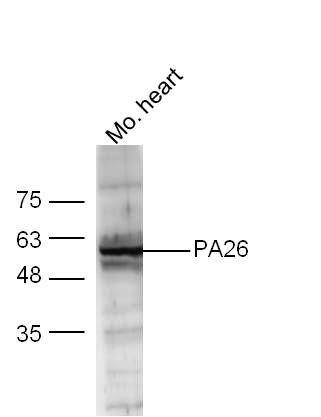产品货号 : mlR8325
英文名称 : PA26
中文名称 : p53调控PA26核蛋白抗体
别 名 : p53 regulated PA26 nuclear protein; p53 regulated protein PA26; p53-regulated protein PA26; PA26; sesn1; SESN1_HUMAN; SEST1; sestrin 1; Sestrin-1.
研究领域 : 细胞生物 免疫学 信号转导
抗体来源 : Rabbit
克隆类型 : Polyclonal
交叉反应 : Human, Mouse, Rat, Dog, Cow, Horse, Sheep,
产品应用 : WB=1:500-2000 ELISA=1:500-1000 IHC-P=1:400-800 IHC-F=1:400-800 Flow-Cyt=3ug/Test IF=1:50-200 (石蜡切片需做抗原修复)
not yet tested in other applications.
optimal dilutions/concentrations should be determined by the end user.
分 子 量 : 57kDa
细胞定位 : 细胞核
性 状 : Lyophilized or Liquid
浓 度 : 1mg/ml
免 疫 原 : KLH conjugated synthetic peptide derived from human SESN1/PA26:401-492/492
亚 型 : IgG
纯化方法 : affinity purified by Protein A
储 存 液 : 0.01M TBS(pH7.4) with 1% BSA, 0.03% Proclin300 and 50% Glycerol.
保存条件 : Store at -20 °C for one year. Avoid repeated freeze/thaw cycles. The lyophilized antibody is stable at room temperature for at least one month and for greater than a year when kept at -20°C. When reconstituted in sterile pH 7.4 0.01M PBS or diluent of antibody the antibody is stable for at least two weeks at 2-4 °C.
PubMed : PubMed
产品介绍 : Cell cycle progression is subject to arrest at G1 and G2 checkpoints in response to DNA damage, presumably to allow time for DNA repair prior to entry into S and M phase, respectively. The p53 tumor suppressor is required for one such G1 checkpoint and functions to upregulate expression of GADD 45 and the mitotic inhibitory protein p21. GADD 45 stimulates DNA excision repair in vitro and inhibits entry of cells into S phase, and it apparently acts in concert with GADD 153 in inducing growth arrest. A related DNA-damage inducible gene, GADD 34 synergizes with GADD 45 or GADD 153 in suppressing cell growth. PEG-3 (progression elevated gene-3) shares significant homology with GADD 34 and is inducible by DNA damage. An additional GADD related gene, PA26, is a possible target of p53. Three isoforms of PA26 have been identified as PA26-T1, PA26-T2 and PA26-T3.
Function:
Involved in the reduction of peroxiredoxins. May also be regulator of cellular growth.
Subcellular Location:
Nucleus.
Tissue Specificity:
Widely expressed.
Post-translational modifications:
Phosphorylated upon DNA damage, probably by ATM or ATR.
Similarity:
Belongs to the sestrin family.
SWISS:
Q9Y6P5
Gene ID:
27244
Important Note:
This product as supplied is intended for research use only, not for use in human, therapeutic or diagnostic applications.
产品图片












